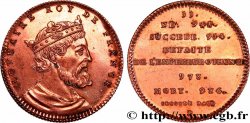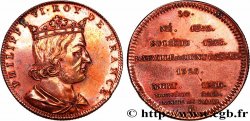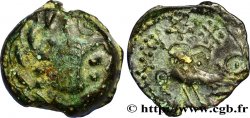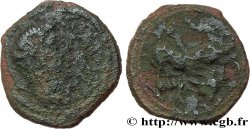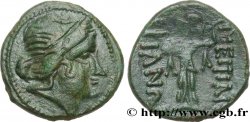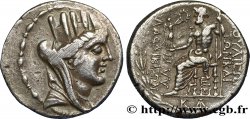E-auction 645-654448 - fme_1018755 - METALLIC SERIES OF THE KINGS OF FRANCE Médaille, Philippe IV Le Bel - 45 - refrappe ultra-moderne
You must signin and be an approved bidder to bid, LOGIN TO BID. Accounts are subject to approval and the approval process takes place within 48 hours. Do not wait until the day a sale closes to register. Clicking on « bid » constitutes acceptance of the terms of use of cgb.fr private e-auctions.
Bids must be placed in whole Euro amounts only. The sale will start closing at the time stated on the item description; any bids received at the site after the closing time will not be executed. Transmission times may vary and bids could be rejected if you wait until the last second. For further information ckeck the E-auctions F.A.Q.
NO BUYER'S FEE.
NO BUYER'S FEE.
| Estimate : | 20 € |
| Price : | 6 € |
| Maximum bid : | 20 € |
| End of the sale : | 25 August 2025 20:02:00 |
| bidders : | 2 bidders |
Type : Médaille, Philippe IV Le Bel - 45 - refrappe ultra-moderne
Date: n.d.
Metal : gilt bronze
Diameter : 34 mm
Orientation dies : 12 h.
Weight : 20,95 g.
Edge : Cannelée
Puncheon : corne d’abondance
Rarity : R1
Coments on the condition:
Patine hétérogène avec des traces de manipulation et rayures
Obverse
Obverse legend : PHILIPPE IV ROY DE FRAN. ET DE NAVAR..
Obverse description : Buste imaginaire couronné et drapé à droite.
Reverse
Reverse legend : 45. / NÉ 1268. / SUCCEDE. 1285. / LIBERTEZ DU ROIAUME / MAINTENUES. / CONCILE GENERAL / A VIENNE. / MORT. 1314. / TROISIEME RACE. / P..
Reverse description : Légende en 10 lignes.
Commentary
Médaille conservée sous capsule et dorée à l’or fin. Refrappe ultra-moderne des séries de jetons.
Philippe IV de France, dit Philippe le Bel (Fontainebleau, avril/juin 1268 - Fontainebleau, 29 novembre 1314) fils Philippe III de France (1245-1285) et de sa première épouse Isabelle d'Aragon. Il fut roi de France de 1285 à 1314, onzième roi de la dynastie des Capétiens directs.
Son père confie une partie de l'éducation du jeune Philippe à Guillaume d'Ercuis, son aumônier. À la différence de son père, Philippe le Bel reçoit par le soin de son précepteur une bonne éducation Il comprend le latin et aime étudier.
Surnommé par ses ennemis tout comme par ses admirateurs le « roi de marbre » ou « roi de fer », il se démarque par sa personnalité rigide et sévère. L'un de ses plus farouches opposants, l'évêque de Pamiers Bernard Saisset, dit d'ailleurs de lui : « Ce n'est ni un homme ni une bête. C'est une statue. » Philippe le Bel fut un roi qui souleva au cours de son règne beaucoup de polémiques, le pape Boniface VIII le traitant par exemple de « faux-monnayeur ».
Sous le règne de Philippe IV, les traditions féodales sont abandonnées pour mettre en place une administration moderne. Mais la centralisation monarchique mécontente les grands seigneurs et les nouveaux impôts dressent les bourgeois contre le pouvoir royal.
Grâce à l'aide de juristes, notamment son fidèle collaborateur Guillaume de Nogaret , Philippe IV transforme véritablement un État encore féodal en une monarchie moderne où la volonté du roi s'impose à tous, et un impôt national est prélevé sur tout le royaume de France.
Son règne est particulièrement agité sur le plan monétaire. Le roi et ses conseillers multiplient les émissions de nouvelles monnaies. Aux dévaluations succèdent les réévaluations, qui donnent un sentiment d'incohérence de la politique royale. Ces mutations monétaires aboutissent finalement à un mécontentement général dans le royaume. Entre 1306 et sa mort, le roi fait face à des émeutes populaires mais aussi à des ligues nobiliaires qui exigent, entre autres, le retour à la bonne monnaie.
Pour la suite de la biographie, voir http://fr.wikipedia.org/wiki/Philippe_IV_de_France.
Medal preserved in a capsule and gilded with fine gold. Ultra-modern re-minting of token series.
Philip IV of France, known as Philip the Fair (Fontainebleau, April/June 1268 - Fontainebleau, November 29, 1314) son of Philip III of France (1245-1285) and his first wife Isabelle of Aragon. He was King of France from 1285 to 1314, eleventh king of the direct Capetian dynasty.
His father entrusted part of the education of the young Philippe to Guillaume d'Ercuis, his chaplain.. Unlike his father, Philip the Fair received a good education from his tutor. He understood Latin and enjoyed studying..
Nicknamed by his enemies and admirers alike the \\\"marble king\\\" or \\\"iron king\\\", he stood out for his rigid and severe personality.. One of his fiercest opponents, the Bishop of Pamiers Bernard Saisset, said of him: \\\"He is neither a man nor a beast.\\\". It's a statue. » Philip the Fair was a king who aroused much controversy during his reign, with Pope Boniface VIII, for example, calling him a \\\"counterfeiter.\\\".
During the reign of Philip IV, feudal traditions were abandoned to establish a modern administration.. But the monarchical centralization displeased the great lords and the new taxes set the bourgeoisie against the royal power..
With the help of jurists, notably his faithful collaborator Guillaume de Nogaret, Philip IV truly transformed a still feudal state into a modern monarchy where the will of the king was imposed on all, and a national tax was levied on the entire kingdom of France..
His reign was particularly turbulent on the monetary level.. The king and his advisors multiply the issues of new coins. Devaluations are followed by revaluations, which give a feeling of incoherence in royal policy.. These monetary changes ultimately led to general discontent in the kingdom.. Between 1306 and his death, the king faced popular riots but also noble leagues which demanded, among other things, a return to good coin..
For the rest of the biography, see http://fr. Wikipedia. org/wiki/Philippe_IV_de_France
Philippe IV de France, dit Philippe le Bel (Fontainebleau, avril/juin 1268 - Fontainebleau, 29 novembre 1314) fils Philippe III de France (1245-1285) et de sa première épouse Isabelle d'Aragon. Il fut roi de France de 1285 à 1314, onzième roi de la dynastie des Capétiens directs.
Son père confie une partie de l'éducation du jeune Philippe à Guillaume d'Ercuis, son aumônier. À la différence de son père, Philippe le Bel reçoit par le soin de son précepteur une bonne éducation Il comprend le latin et aime étudier.
Surnommé par ses ennemis tout comme par ses admirateurs le « roi de marbre » ou « roi de fer », il se démarque par sa personnalité rigide et sévère. L'un de ses plus farouches opposants, l'évêque de Pamiers Bernard Saisset, dit d'ailleurs de lui : « Ce n'est ni un homme ni une bête. C'est une statue. » Philippe le Bel fut un roi qui souleva au cours de son règne beaucoup de polémiques, le pape Boniface VIII le traitant par exemple de « faux-monnayeur ».
Sous le règne de Philippe IV, les traditions féodales sont abandonnées pour mettre en place une administration moderne. Mais la centralisation monarchique mécontente les grands seigneurs et les nouveaux impôts dressent les bourgeois contre le pouvoir royal.
Grâce à l'aide de juristes, notamment son fidèle collaborateur Guillaume de Nogaret , Philippe IV transforme véritablement un État encore féodal en une monarchie moderne où la volonté du roi s'impose à tous, et un impôt national est prélevé sur tout le royaume de France.
Son règne est particulièrement agité sur le plan monétaire. Le roi et ses conseillers multiplient les émissions de nouvelles monnaies. Aux dévaluations succèdent les réévaluations, qui donnent un sentiment d'incohérence de la politique royale. Ces mutations monétaires aboutissent finalement à un mécontentement général dans le royaume. Entre 1306 et sa mort, le roi fait face à des émeutes populaires mais aussi à des ligues nobiliaires qui exigent, entre autres, le retour à la bonne monnaie.
Pour la suite de la biographie, voir http://fr.wikipedia.org/wiki/Philippe_IV_de_France.
Medal preserved in a capsule and gilded with fine gold. Ultra-modern re-minting of token series.
Philip IV of France, known as Philip the Fair (Fontainebleau, April/June 1268 - Fontainebleau, November 29, 1314) son of Philip III of France (1245-1285) and his first wife Isabelle of Aragon. He was King of France from 1285 to 1314, eleventh king of the direct Capetian dynasty.
His father entrusted part of the education of the young Philippe to Guillaume d'Ercuis, his chaplain.. Unlike his father, Philip the Fair received a good education from his tutor. He understood Latin and enjoyed studying..
Nicknamed by his enemies and admirers alike the \\\"marble king\\\" or \\\"iron king\\\", he stood out for his rigid and severe personality.. One of his fiercest opponents, the Bishop of Pamiers Bernard Saisset, said of him: \\\"He is neither a man nor a beast.\\\". It's a statue. » Philip the Fair was a king who aroused much controversy during his reign, with Pope Boniface VIII, for example, calling him a \\\"counterfeiter.\\\".
During the reign of Philip IV, feudal traditions were abandoned to establish a modern administration.. But the monarchical centralization displeased the great lords and the new taxes set the bourgeoisie against the royal power..
With the help of jurists, notably his faithful collaborator Guillaume de Nogaret, Philip IV truly transformed a still feudal state into a modern monarchy where the will of the king was imposed on all, and a national tax was levied on the entire kingdom of France..
His reign was particularly turbulent on the monetary level.. The king and his advisors multiply the issues of new coins. Devaluations are followed by revaluations, which give a feeling of incoherence in royal policy.. These monetary changes ultimately led to general discontent in the kingdom.. Between 1306 and his death, the king faced popular riots but also noble leagues which demanded, among other things, a return to good coin..
For the rest of the biography, see http://fr. Wikipedia. org/wiki/Philippe_IV_de_France








 Report a mistake
Report a mistake Print the page
Print the page Share my selection
Share my selection Ask a question
Ask a question Consign / sell
Consign / sell
 Full data
Full data


